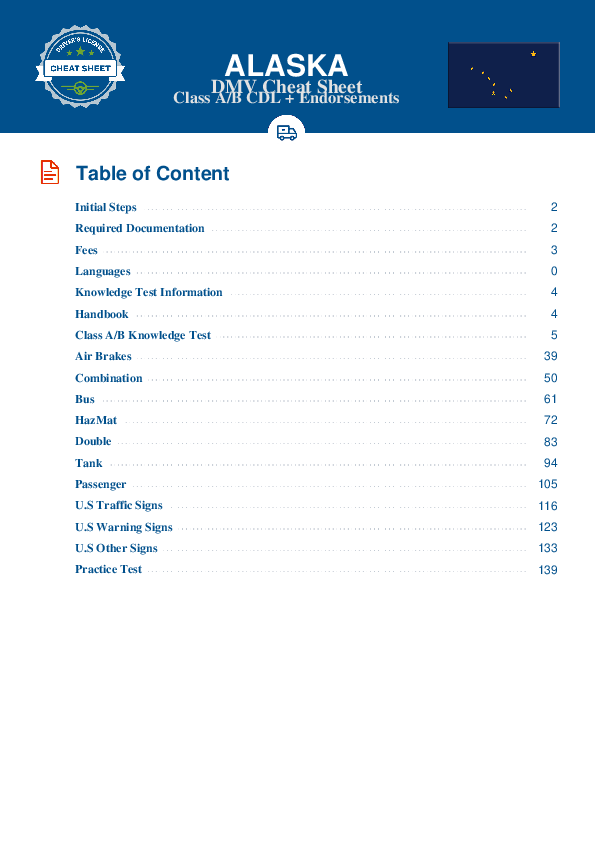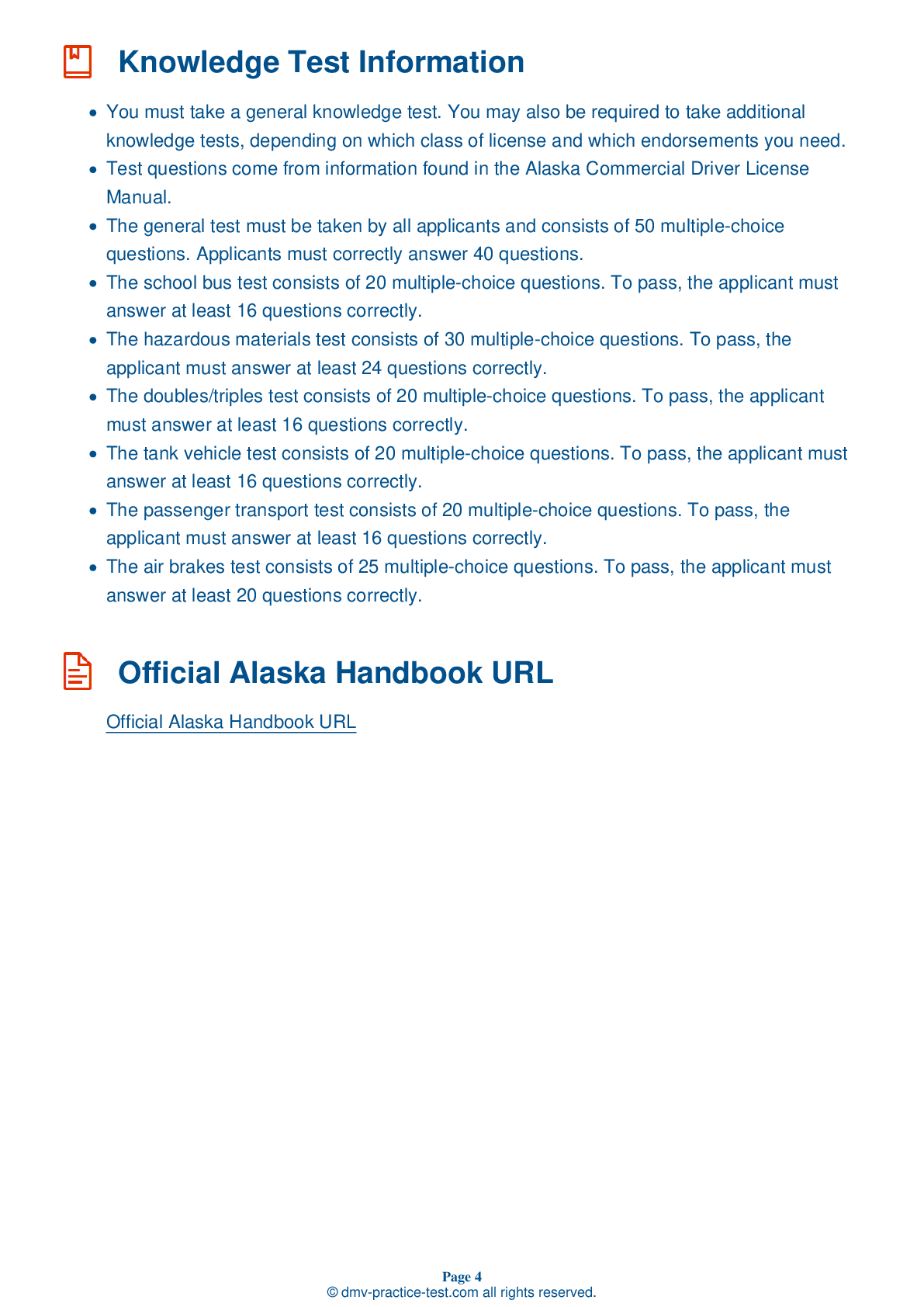Knowledge Test Class A #2
Class A Driving Test | Alaska 2025 #2 Page 7 of 7
Train for FREE online with our Alaska class A license test. The official exam test consists of several obligatory parts, with all of them checking your knowledge of different blocks of road rules. If you need to obtain a AK CDL class A permit in 2025, practice as much as possible. Free sample tests published on our website will help you check and improve your knowledge and boost your grades. Please bear in mind that CDL class A requirements may vary from state to state.
50
40
20
43 . While driving, gauges are:
While driving, you should watch your vehicle's gauges for signs of trouble. Be sure to inspect your gauges before beginning a trip to ensure that they are in proper working order.
44 . If a load is 10 feet long, it should be secured by a minimum of:
Cargo should be restrained by at least one tie-down for every 10 feet of cargo. However, all cargo should have at least two tie-downs, no matter the size of the cargo.
45 . You should not use your mirrors:
While regular mirror checks should be a part of your driving routine, it is particularly important to check your mirrors when changing lanes, turning, merging, and making tight maneuvers.
46 . When making a left turn where there are two available turn lanes, a driver should begin the turn in the rightmost lane because:
If making a left turn where there is more than one available turn lane, you should always choose to begin your turn in the rightmost lane. Large vehicles often have to swing right to make left turns. Because of this, it is safer for you to have other left-turning traffic to your left instead of to your right. This will allow you to have the best possible view of other turning vehicles and will lower the risk of your vehicle colliding with them.
47 . When traveling at speeds under 40 mph, you should maintain at least ____ of following distance for every 10 feet of your vehicle's length.
When traveling at speeds under 40 mph, you should allow a minimum of one second of following distance for every 10 feet of your vehicle's length. At faster speeds, add at least one additional second.
48 . If you have an engine fire, you should:
To keep an engine fire from spreading, you should turn off the vehicle's engine as soon as possible. Do not open the hood if you don't have to.
49 . Looking far ahead of your vehicle while driving is:
Good drivers look down the road at least 12 to 15 seconds ahead of their vehicles. This makes it possible to identify hazards early, when drivers are more likely to have time to respond appropriately.
50 . When you must travel down a hill, when should you switch into a lower gear?
You should always slow down and shift into a lower gear before starting down a hill. If you do not begin to drive down a hill at a low enough speed, you risk overusing your brakes, causing them to overheat and fade.
2025 Alaska | Frequently Asked Questions
A CDL Class A license in Alaska is defined as a commercial driver's license that allows holders to operate any combination of vehicles with a Gross Vehicle Weight Rating (GVWR) of 26,001 pounds or more, provided the towed vehicle is heavier than 10,000 pounds. It typically covers vehicles like tractor-trailers, truck and trailer combinations, tank vehicles, and livestock carriers.
A Class A CDL license in Alaska allows the holder to operate vehicles such as tractor-trailers, truck and trailer combinations, flatbeds, livestock carriers, and tank vehicles. The license covers any combination of vehicles with a Gross Vehicle Weight Rating (GVWR) of 26,001 pounds or more, given the towed vehicle exceeds 10,000 pounds.
To obtain a Class A CDL license in Alaska, you must be at least 18 years old (21 for interstate driving), possess a valid driver's license, pass a vision test, and complete a written knowledge test. You're also required to pass a skills test, which includes a pre-trip vehicle inspection, a basic vehicle control test, and an on-road driving exam.
In Alaska, you must be at least 18 years old to obtain a Class A CDL for intrastate driving (within state lines). However, federal regulations require drivers to be at least 21 years old to drive commercial vehicles across state lines (interstate) or to transport hazardous materials.
While specific endorsements aren't required for a Class A CDL, they allow you to operate specialized vehicles. Endorsements include H (Hazardous Materials), N (Tank Vehicles), P (Passenger Vehicles), S (School Buses), T (Double/Triple Trailers), and X (Combination of Tank Vehicle and Hazardous Materials). Each requires an additional knowledge test, and some require a skills test.
The Class A CDL skills test in Alaska consists of three parts: a pre-trip vehicle inspection to assess your ability to determine if your vehicle is safe to drive, a basic vehicle control test to evaluate your ability to control the vehicle, and an on-road driving exam where you demonstrate your ability to safely drive the vehicle on public roads.
Yes, there are limitations for Class A CDL license holders. These include restrictions based on the driver's experience, age, health status, and specific vehicle features. For instance, drivers may have restrictions if they fail the air brake portion of the test or if they drive a vehicle without a full air brake system. Also, drivers under 21 are restricted to intrastate driving.
In Alaska, the written Class A CDL test is primarily administered in English to ensure drivers can understand road signs and signals. However, the state allows the use of translators or interpreters for those who don't speak English fluently. It's advisable to contact your local DMV office beforehand to confirm their specific policies regarding language assistance.
Yes, accommodations can be made for the Class A CDL written test in Alaska if you have a disability. You need to inform the DMV about your specific needs when scheduling your test. They can provide aids such as audio versions of the test, extra time, or quiet testing environments depending on your requirements.
Yes, if you don't pass the Class A CDL written test in Alaska, you can retake it. However, you must wait at least one day before retaking the test. The Alaska DMV allows multiple attempts, but repeated failures may require additional training or instruction before another attempt is allowed. Fees may apply for each test attempt.



